|
I've written about this page before, when it was page 12 (I added some pages to the story). It was redrawn from a panel for my abortive original version of the story, and was one of the first I used 3D models on. I was very pleased with at he time, but now it looks less good, indicating that I've gotten better at inking over the 3D models.
I've only just finished flatting it. Partly I left it off as I have to add a drawing he is working on, that will also appear on other panels, and which i haven't done yet. Although I did some as I went along, I've been trying to leave my drawings of the drawings (and also the related imagined scenes) to do them all together at the end.
0 Comments
Below is my (very) rough breakdown/sketches for the final page - it probably first needs some explanation, as to what is meant to be happening. Row 1 is Salimbini (the patron) with Uccello after he has seen and accepted the progress represented by the completed 'cartoon' for the first painting. I also added Rocco (the patron's major demo) to this scene, as he had played a key role in enabling Uccello's breakthrough that let him turn a set of studiess into the complete scene. As discussed in the post below, I had turned these two panels into a single wide panel, on the previous page, however I may have to return it to the final page to put a 'moment of reaction' panel on the previous page. Row 2 shows Uccello walking home and passing his sculptor friend Donatello. I am thinking now I should add the other artist, Ghiberti, to this panel. Donatello, like Uccello, was a pupil of Ghiberti, so it's perfectly likely that they could be together. I will need rework on the dialogue for that row. to give Ghiberti a line. The sculptor Donatello, is meant to come across as a friend, even though he is shown as cheekily mocking of his friend's somewhat theoretical approach to 3 dimensions in art. Donatello was a key figure in the return to the lost classical techniques of sculpture in the round. as a sculptor, Donatello is not a rival in the direct sense of competing for the same jobs, whereas Ghiberti feels Uccello has chanced upon a job that Ghiberti's studio would have been better placed for. Possible lines:
Row 3 shows Uccello reunited with his wife, after being essentially held prisoner at the patron's pending 'a satisfactory position...'. In the first panel (I may not use borders) he arrives on the imaginary steed. In the second panel we see his wife pulled up onto the steed - this mirrors her monetary fantasy of being carried away from there difficult marriage to Uccello, by the heroic horseman from his earlier painting (page 3), and suggests the narrative concept of a 'new equilibrium' at the end of the story, may extend from his work life into his domestic life. I've made some of the chances in the updated version below, with panel 1, being pasted in from the previous page. The rest may not look very much, but I'm now clearer and more confident in my mind for tackling this crucial last page. I may omit the panel border(s) for the middle row, to suggest Uccello's sense of release. I could draw in some of the ground, which would act as divider between this and the borderless row below. 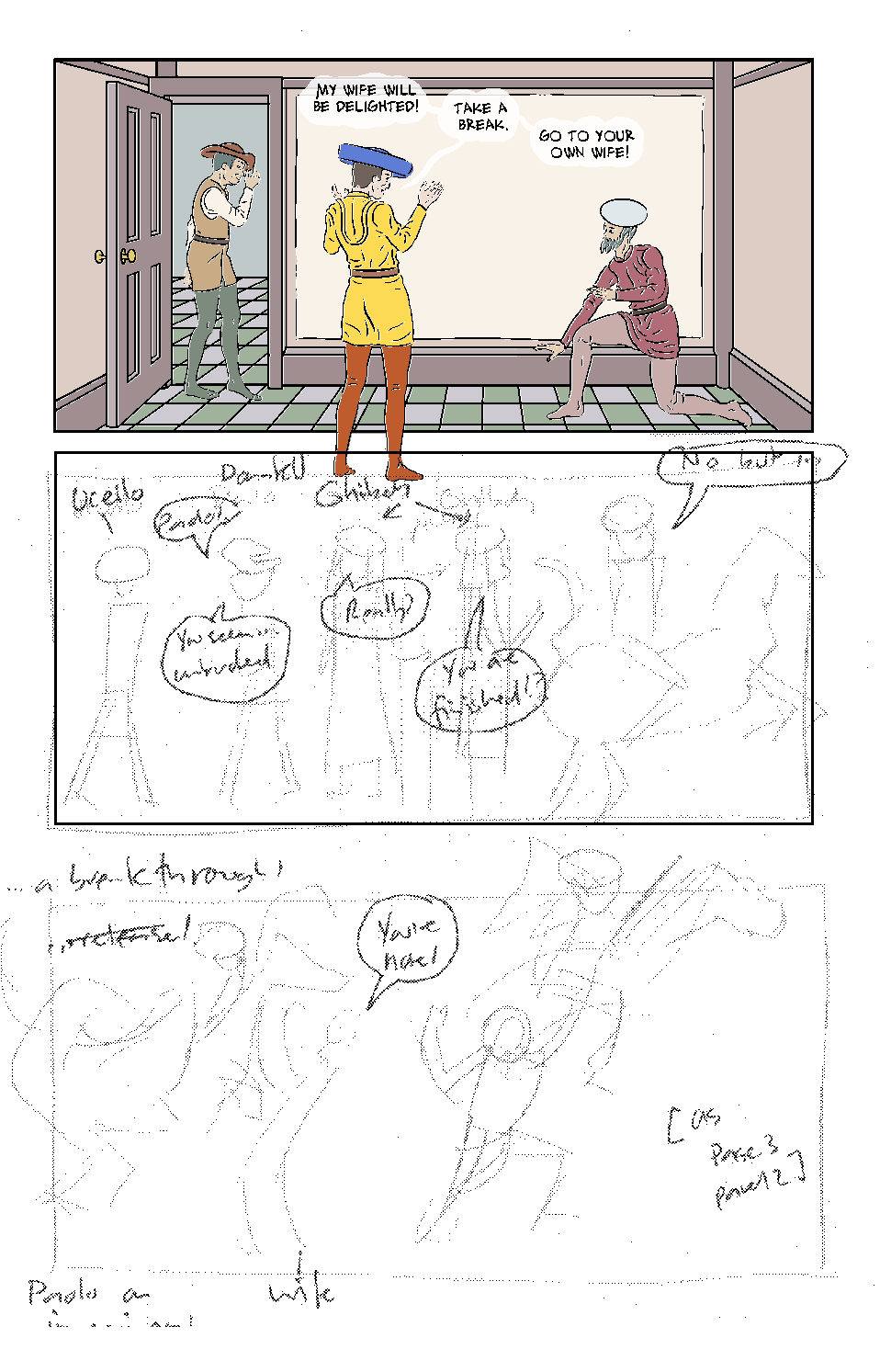 The image above seems to have slightly offset the inks layer from the colour - it looked okay in Manga Studio, and I'm sure it's easily fixed. Below is the panel, (below, right) from page 3, of Uccello's wife (there is no record of her name) imagining herself being swept away by the rider in her husband's painting (below, left). the final panel of my story (sketched above) mirrors this, but with the revitalised Uccello on an imaginary horse, sweeping her away.
I finished drawing and inking the last panel of the spread pages 20-21. I did agonise/labour over the poses in this more than usual, but that seemed appropriate, as it is a key part of the conclusion.As noted in post 4 on this topic, Uccello getting up from the floor, was particularly difficult. I've opted for a later moment i that action, and am fairly pleased with it, although an unintentional effect is that he appears to be leaning his right hand on the skirting. I'll sleep on that, before deciding if it need changed. I said in the previous post that I wanted to have Rocco tip his hat to Uccello, in acknowledgement that the former's gamble had paid off for both of them. Moving Salimbini back from the painting (and so towards the reader, and out of the panel) meant he was not in the way of the look between the other two. Panels 2 and 3, will of course, have a more finished version of the drawing seen in progress in panel 1. I've now flatted these pages. I've still to complete the drawing for Uccello's painting, for panels 2 and 3. I see in the picture below, I have not finished the hair/beard of theta left Uccello - fixed now! In composing this scene I did think about where to put the vanishing point. There would have been some appeal to making it run along the join of the two pages, - to give a symmetry to the spread, but in the end I decided it was better to align it with the vanishing point in the drawing - just at the raised baton, where I've put Uccello's hand.
Actually, looking now, at this sequence, I wonder if it needs an extra panel (between 2 and 3 as seen here) with the moment of the patron seeing the painting and deciding it is good. the contents of panel 3 were meant to be on the last page, and i moved them forward. This would have given me a large last panel, though if I move the last panel here back, what I lose in visual impact, I may gain in structural elegance,. It will be a three panel page, featuring a key character/set in each panel: Salimbini and Rocco in 1 (moved from panel 3 here), Donatello and Ghiberti in panel 2, and Uccello reunited with his wife in panel 3. I'll keep this in mind as I finalise the next and last page. I have more to do on the double-page spread pages 20-21, however, I'm working from home today (to make it seem like a Sunday off!), and due to delays in files updating to Dropbox, I'm having to work on a different page. By way of context, page 13 comes after the page (below) where his old master tells him he should go and sketch horses and riders in real life. ,My initial idea for page 13, was to simply have six panels of different sketches of horses - to suggest these were Uccello's drawings. However, I felt that I could come up with something that was more interesting (which would inevitably mean more work for myself!). I decided to create a montage effect around a scene of Uccello drawing a horseman. I already had an inked drawing of a horseman, which was originally on page 12. It's a drawing of the same image of a rider with a baton, leading the charge, that we saw imagined on page 1. My intention was to base all the images of horses on the paintings the comic is about - so that for the reader, they will see all these sketches worked into the final painting. The problem with this drawing on page 12 was that while the reader was seeing it the right way round (as it appears in the painting) Uccello was drawing it from the opposite, and so wrong, side. On page 13, the viewpoint is flipped so that we are looking over Uccello's shoulder, and so seeing his subject as he draws it. In short, the drawing makes sense on page 13, which I am working on. I found images of riders in the paintings (that are the subject of my comic). Rather than simply put these in a panel style grid, I decided to have then in a looser arrangement. What I arrived at, was to organise them in an almost circular, clockwise, order. I also arranged the images within that forame, in an escalating fashion, which also reads as a chronological sequence: so the first image shows a rider: then a rider with a raised lance, then a rider with a lowered and aimed lance; a rider falling off his horse (as if hit by a lance - as it will appear in the painting); and then, completing the sequence, two images of fallen horses. The pose the 'real' rider is in, is not included in that sequence, as that seemed redundant, and I had the better idea to have it be the current one on Uccello's drawing board. Initially, I tried drawing these to look like rough sketches, but I thought they betrayed a incongruously modern simplification, indeed abstraction. In response to this I redrew them in more finished form, closer to how they appeared in Uccello's paintings, but with the rider as shown, and armoured like most of the figure in the finished painting. Hopefully this is the right amount of information for the reader to ' join the dots'. to the figures in the final design - seen later in the story. I have a range of pencil tools in Manga Studio, but had to experiment to see what (ironically) was going to read best as pencil on the printed page. I've also had problems before, with finding good techniques, and then when I wanted to replicate them, being unable to remember how! To preempt that, this time I used the text tool within MS to write down what pencils and settings I'd used (and then turned off its visibility).
I made a number of other changes from the previous draft, including changing the drawing board, and Uccello's hand to be more convincing that he is holding it, for support, as it rests on his legs. I also risked, and repositioned the sketched horses to make a better overall composition. When I come to draw in the paper edges, I'll no doubt have to tweak this. It took a few attempts for the stool, even though I have now drawn it a few times. It's necessary to have the legs look correctly angled from the seat, and have the horizontal beams look like a rectangle in perspective. I also made the different legs different thicknesses depending how close they are to the 'camera'. Like other aspects of perspective - it may not be noticeable that I've gone to the bother to get that right, but it might be noticeable if i hadn't! I still think the stool is not perfect, and the legs should probably be proportionately wider (to match other panels) . but I'll wait and see whether it continues to annoy me, or I stop noticing it! It's more usual to hold off any colouring until the pencils/inks are completed, but i was finding to hard to visualise how the whole page would look, and so how well the drawings were working, which I is why I flat coloured the picture of Uccello and the his horseman model. this did do its job and reassured me that the overall effect would be coherent. The drawings won't be coloured in the same way (they're meant to look like drawings!), though I may give the 'sheets of paper' they are on, an off-white paper colour. I won't put them on the bitmap inks layer, as I'll probably want to grey them out a bit, or similar, and it'll be no problem to add the paper colour later to the same flats layer (I make it a multiply layer, so I can bucket fill shapes not on the bitmap inks layer.. A number of elements will be changed from this draft version. The sketches in orange won't appear in that form, but I may have some kind of sketching effect over/underlaid on the more finished looking sketches, to suggest a process, and that they are working drawings rather than finished works of art.The paper edges aren't very good, at present, and I can finesse them. These various changes should improve the finished page. I'm now working on panel 3, at the bottom right of this two-page spread. I've spent a bit of time with the 3D models trying to find the right pose for Uccello, who was sleeping on the floor in the previous panel. I first of all tried working from the pose from the previous panel (post immediately below), which I had been quite pleased with. Using reference shots on the internet, I reposed this to suggest him getting up from the position he had been in. While that looked good in some ways, it didn't seem to fit with my idea of the time elapsed from the previous panel, where i was thinking that the patron ad time to take in the artwork eve before speaking the three lots of text above. I other words it doesn't make sense for Uccello to still be on the ground at that point, given he is with a patron, and as we have established, powerful man. I tried him further in the process of sitting up, and yawning. Even though he has just woken up, such a theatrical yawn in from of a patron, who was already dissatisfied with him, might seem like a deliberate provocation.
The last one might do, with a bot o tweaking. perhaps I am over-thinking this, I haven't agonised this much over other panels. but this spread is the climax of the story, so genuinely important. It might help to move some of the word balloons towards the right, which will reduced the experience of time passing before he has stood up. that's to say, the word ballots will them appear to happen after the moment Uccello is picture, because of the tradition of reading left to right. Of course, if I just drew Uccello stood up, it's unlikely many people would see anything wrong with that, but I do want to get the most out of this panel. I think I'll work on the other figures/other pages, and come back to this. I have done some further work on this double-page spread. I have inked over the 3D models. I used a pencil layer to very roughly sketch in Uccello's clothes. I don't do 'full pencils' - that seems to defeat the purpose of doing it on the computer. I have also added in parts of the drawn image, which corresponds to Uccello's actual painting (first in the series of three) - those shown are all pasted in from earlier pages, where we seen them as studies, or else imaginary images, as seen on Page 1 where Uccello is imagining the scene as described by various witnesses. It doesn't seem to read as elegantly as the 3D models over a photo of the actual painting ( as previously posted), it looks a bit messy and cluttered, but I hope that will be solved simply by colouring the figures and room. The figures in Uccello's drawing won't be in colour. I'll omit the drawing when I create the bitmap inks layer. So by these methods i should be able to make the drawing read as a discrete element in the overall composition. Note that this is a double page spread - so intended to be seen rather bigger than it appears here. This spread doesn't fall in the centre pages, so it'll be printed on two separate sheets, so i avoided having any of the figures cross the centre line/join. It seems an easy thing to paste components together, but these were all drawn separately in different line styles and weights, and different scales, so there is a lot of work in placing them accurately, so I can build up the rest of Uccello's careful composition around them. Also I've had to spend some time getting the relative tonal balances looking right. The next panel (bottom left) will show an essentially complete drawing of the finished composition, that i will make by adding to the in progress version in the main panel. I actually have some more finished drawings of the riders (used individually on earlier pages) that I kept back to use in panel two. I was pleased with the composition of panel two - it's important here to let the reader see the whole drawing on the wall, and I though this was quick and elegant solution - Uccello on the floor asleep fits well with the story - after Rocco's initially menacing but ultimately helpful intervention, I am trying to suggest in this page that Uccello is in an almost manic state, obsessed with getting his vision down, and working until he dropped. Initially I had omitted Rocco from this panel, but I felt that in narrative terms, as this is the climax of the story, he should appear. It wasn't easy to fit him into the scene: Salimbini needs to have just entered, to convey the precise moment where he sees the sleeping Uccello, but has not yet noticed the drawing. It wouldn't be consistent with their relationship for Rocco to enter before his master, so the only option was to glimpse Rocco in the doorway behind Salimbini. I tried to create the impression that Rocco was trying to catch a glimpse into the room over his master's shoulder. The composition was perhaps slightly better before I added Rocco, but given the difficulty, I think it works pretty well. I'll see if I can do something with the colouring or tone layer to keep Rocco in the background, although his costume being less colourful than his masters may achieve that in itself.
I haven't entirely worked out panel 3, but I think it would have a good symmetry to make it a wide panel to match panel 2. I will show Uccello waking/sitting up, Salimbini admiring the drawing. If I can for it all in, I will have Rocco slightly doff (or at least touch) his hat to Uccello, in ackowledgement of the latter's progress, the success of Rocco's intervention, and to suggest some sort of 'in it together' bond between these two. UPDATE I had a nagging sense that the sleeping Uccello in panel 2 was reminiscent of a classic figure from art - I've just realised it's this painting of the death of the poet Chatterton, by Henry Wallis. While I was happy with the 'Alex Toth' lettering font, and balloon style, the letters seemed a bit too close together (possibly to do with the default settings on Manga Studio 5) and the tutor had suggested some further work on getting the spacing right. I increased the line spacing from 0 to 1.5 (although it's upper case, the hand-written aesthetic means that some letters are slightly raised or lower, and in particular the 'M's have long tails that were a bit too close to the row below. I increased the character spacing from 0 to 1. I quickly resized the balloons to accommodate the more widely space text, but this means some of the balloon tails need adjusted. This same page, with the lettering in it's previous state, can be seen, for comparison, below on the 'Page 7' post from 19/7/2017. I also applied the same lettering settings to a page which has a different style of balloons. Looking at this now, the above style looks better. I think it's perhaps to do with the more rigid edges on the balloons below clashing with the looser lettering style, and in particular it's variation of vertical position. Below I changed the balloons to the type I preferred on page 6, as posted previously. This generally works better, though I think I can still finesse th pacing and edges of some of the balloons. There were still a couple of methodological issues though. In panel five the double balloon is Uccello speaking, which hopefully the rider can be clear about because his wife's balloon has a tail pointing toward her - it was hard to find a place where a tail could end, because going to the edge of the panel to the right, meant it was going towards the figure o his wife in panel 6. I tried running it along the lower part of panel 6, up to Uccello, but that didn't look right either. Also, the text 'into this?' continues Uccello's unspoken thought from the previous page, and this doesn't work as well as version one (top) where it is clearly a thought bubble, distinct from the word balloons. I'll need some more wrought/work on that.
The borderless balloons and tails do tend to look better where they are on a flat colour, as in panels 3, 4 and 6, above, and less well when they are over drawn details. I've posted previously about how upgrading to Manga Studio 5 seemed to slow down my graphics table to the point of unusuability, and I eventually got round this with an app that let me use my iPad Pro and Apple Pencil in lieu of a graphics tablet. This does have an additional advantage that I can also do this on my home Mac, which I'd been doing, due to a few days of not feeling well (and then just being on a roll). When I did go back to my studio, I found I'd left my Apple Pencil at home. I was able to work without this to copy/paste/amend backgrounds, and compose the picture with 3D models (see post immediately below), however I had to hold fire on the inking.
The other problem I'd had at my studio, was slow, interrupted, and eventually kaput internet. This was particularly a nuisance in terms of saving work to Dropbox to access at home. The internet is working now, but often my latest versions of pages are not saved. For example, on page 20 (see post immediately below) I had completed the background and posed 3D models, which have obviously not updated to Dropbox. I had hoped to work from home today (still not feeling 100%, and it's a bit of variety), but it occurs to me that anything I do on that page might cause problems in that I'll have two versions each with changes I will want to keep. I guess I could get round it my saving aa a new page outside of Clip Studio's page management, and then copying over panels, etc - but it's still a nuisance, and there could be unforeseen issues. This is the only two page spread in the story. More correctly, it's a panel that is the full width of the two pages: this aspect ratio reflecting the paintings the story is about.
After Uccello being stuck at the studies stage, and then released by Rocco's intervention (putting him into the armour, and -figuratively - into the battle), he finally pulls his work together into a single scene. The photo of Uccello's painting won't actually be in the scene, though elements of it (as seen on earlier pages) will be at various stages of drawing. I pasted it in here to get the dimensions right, and to help me compose the figures sensitively, in relation to it. I spend some time on arranging the figures, to get some variety in the poses and composition, without obscuring key details of the painting. I managed to place the centre right figure tidily between horse coming from each direction - it looks as he if is organising the battle, or conducting an orchestra. Putting him at the centre of the battle like this demonstrates his change - Rocco's intervention has moved him from a cautious distance to being (figuratively and compositionally) in the centre of the battle. I'll recreate Uccello's picture as a drawing at different stages. I plan to use part pencil and part ink effects, and have thew drawings more developed towards the right - so it reads, and seems to develop with time, left to right in comic tradition. The bottom panel on the left hand page will use the same shot, with the patron entering the door, and Uccello sleeping on the floor. There are a few reasons for this choice: it means the figures are not obscuring the (now largely complete) painting; the comic probably needs the closure of seeing the finished composition; and also we get to see the patron's shock at the sleeping Uccello, before he sees the completed drawing. I haven't fully worked out the panel (s) on the right yet, but making it a single panel would create a pleasingly symmetrical page design. It will show Uccello waking up, as the patron Salimbini looks at the painting, and Rocco gives Uccello a conspiratorial wink or tip of the hat (Rocco's gamble has paid off). Page 7, one of the earliest pages I drew, and needing some reworking, before it was ready to colour. Thewrestrong aspects to the page, I wanted to keep though. In panels 1, 3 - 4, Uccello is asking for help from colleagues, and I deliberately put barriers between them. I did something similar between Uccello and his wife, with the door frame and the open doors creating a gap or void - I have literally put his (lack of) work between them. Panel 5 reprises this shot, but the wife, (excited by the rewards of this commission moves forward) , as he (further daunted by the challenge) moves back. I carefully composed them in relation to the door-frame to emphasise this. The next panel provides a further literal and metaphorical intrusion into Uccello's space, as the patron pops into the room, with the effect of ratcheting up the stakes. I redrew the figure of Donatello in panel 1, the original had too much line stablisation to work at the bigger size, and I also ensured it matched the drawing of him on page 11. I also redrew the backgrounds for the two panels of Uccello and his wife. Panel 4 had been partly pasted and enlarged from panel 3: it mostly worked, but the lines for the tiles were a bit thick, so I reduced the width of them. I also redrew some of the Uccello faces, to be consistent with later drawings. For panel 6, it's only the face of Rocco (right) that is unchanged. I liked the ladder and the perspective lines on the upper panel visually, butI I had drawn it on the basis that he would be working directly onto the upper walls, but I subsequently decided that him being up a ladder would be visually cumbersome, and distract from the interaction of the characters, so I changed this panel. Having made these changes, I was able to do flats. I was noticeable how much quicker it was to flat the more recently drawn panels. I have tended to use the approach of drawing a white layer underneath figures, etc, and would often deliberately leave a white halo around the figure - I sure paid the price for that in the extra time it took me to flat the tiles in the middle row! This page is fairly unusual in containing the full six panels, and also unusual in featuring four different locations. I tried to give them all distinctively coloured walls. I tried to do the same with the floors, though it was difficult. The colour schemes in panel 2/5, and 6 are already set: with hindsight, I would have been better to colour them first on this page to help me keep the new scene (middle row) I tried to do that, but's it's not so effective moving back across pages. Despite the amount of work it was (as noted above) to do the tiles in those panels, I think it may be better to remove them: they are quite busy panels, with a lot on the tiled areas. It may be possible to take down the tiles on a tone layer, though. I may have to redo the balloons, as I going to work on the character and line spacing of the lettering, though i may be able to just enlarge the balloons. On checking the page this morning, I went back and made some minor changes: redrew Rocco's face (panel 6, right) to make it look less vectored); fixed the line spacing on panel 4 balloon 1; added some ink lines for the wife's clothing in panel 5, added colour on pupils (panel 2), etc.
It occurs to me now that I've drawn the woman with a hat in other scenes - am torn between being consistent, and liking these panels as they are... |
AuthorGraham Johnstone ~ Master of Design - Comics and Graphic Novels student 2016-17 Archives
August 2017
Categories |
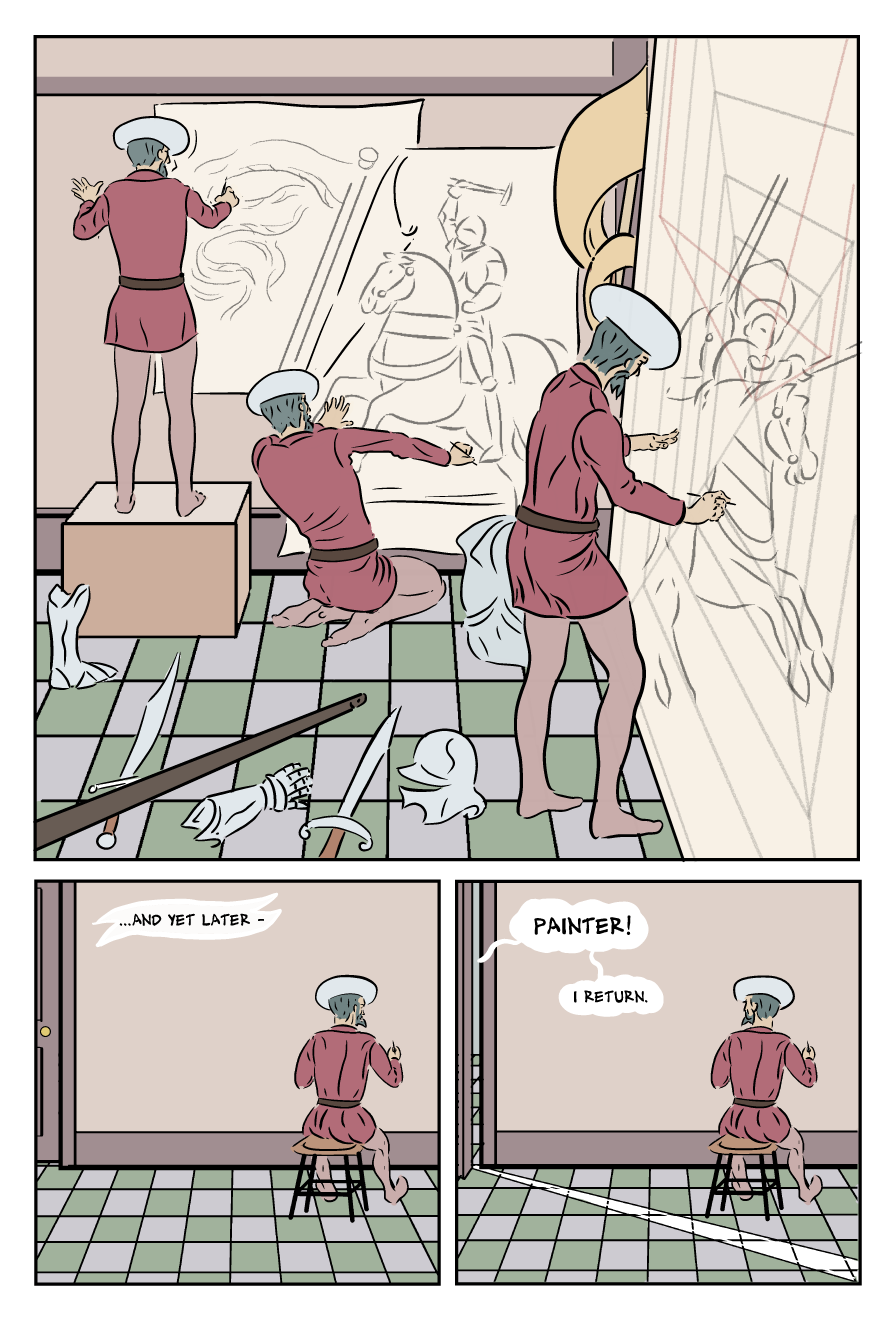
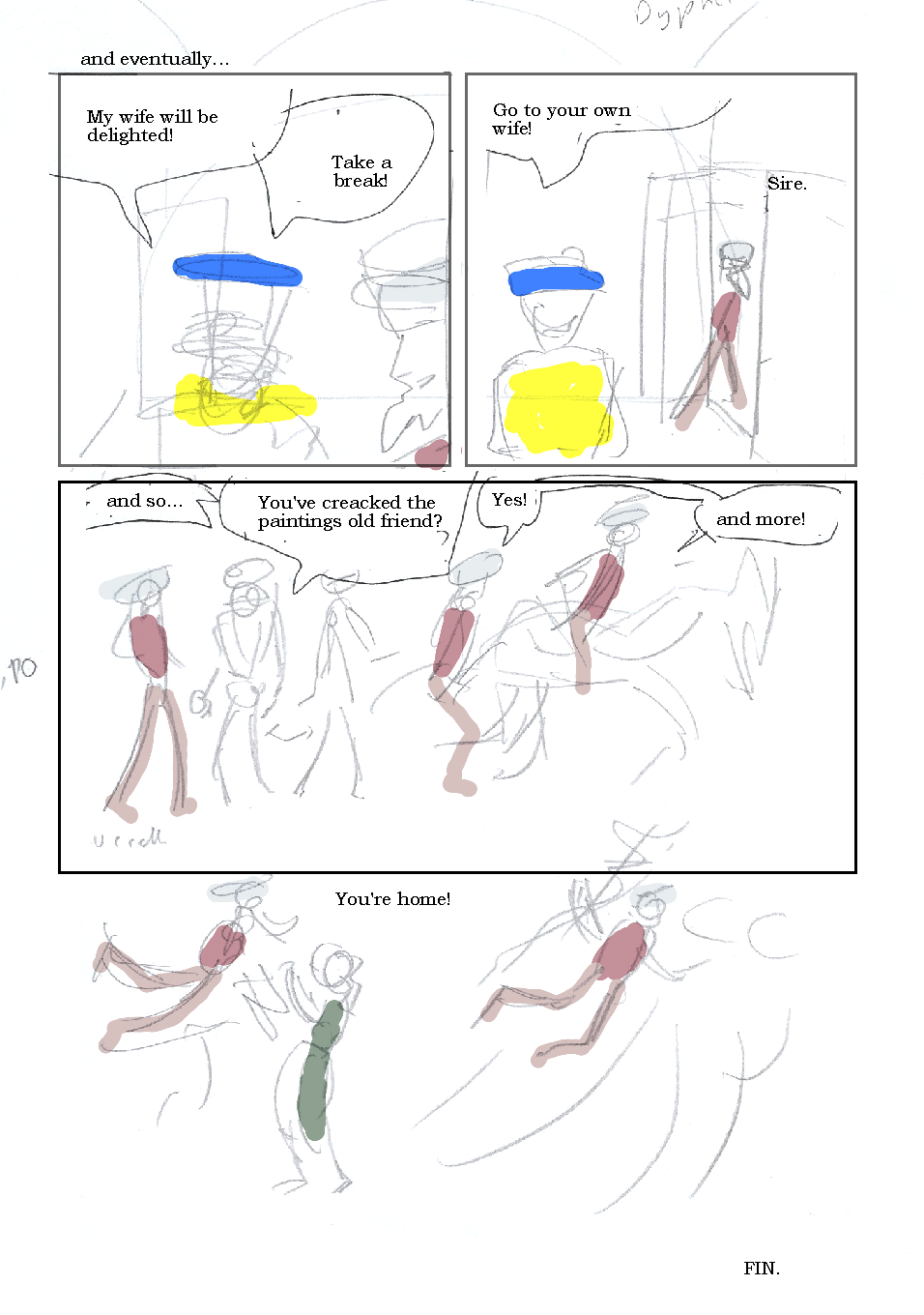
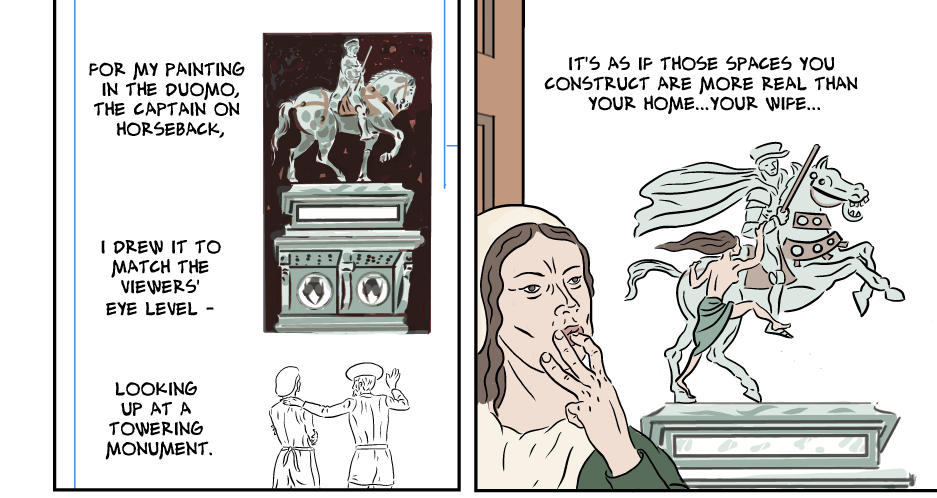
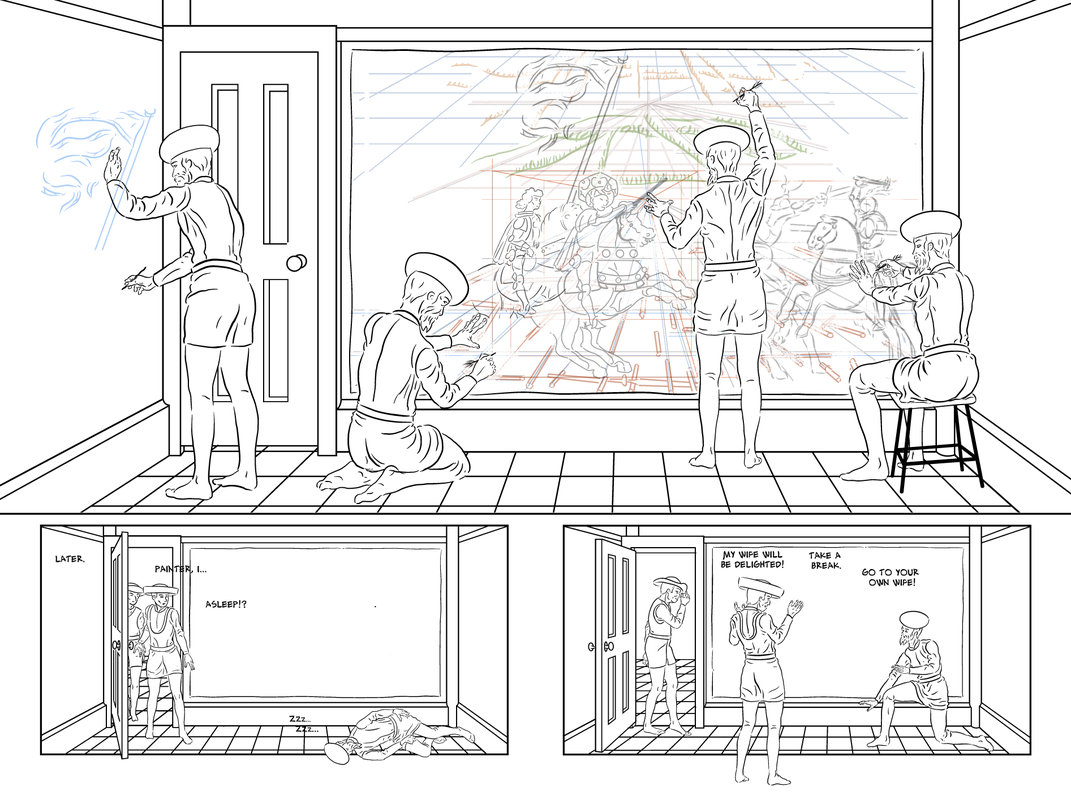
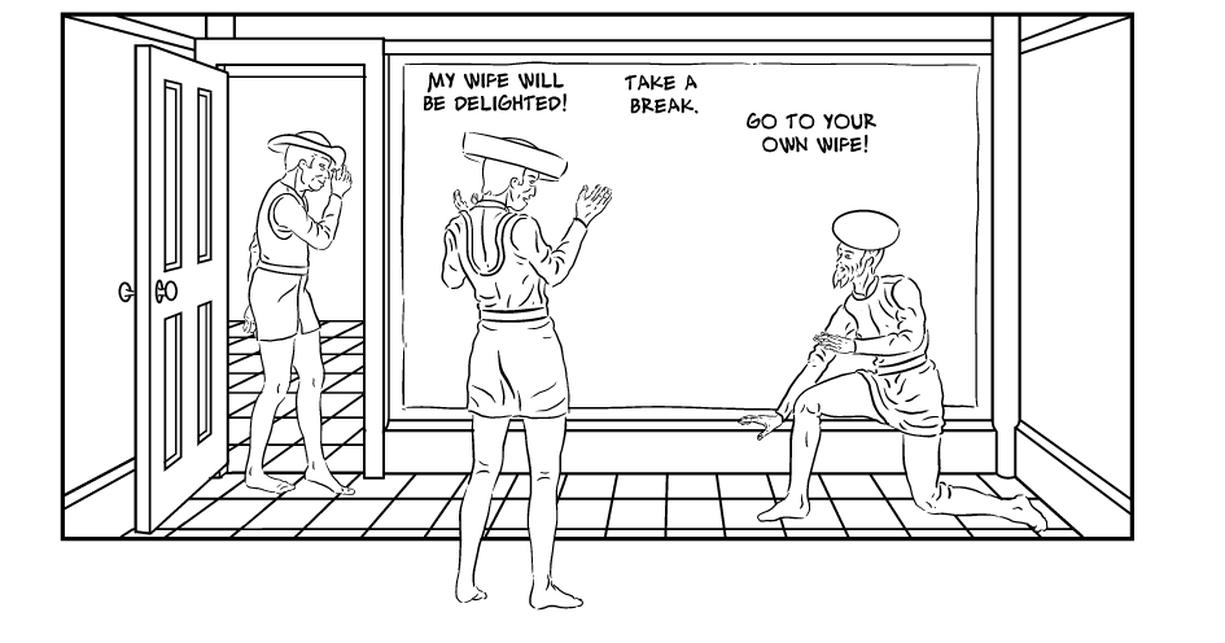
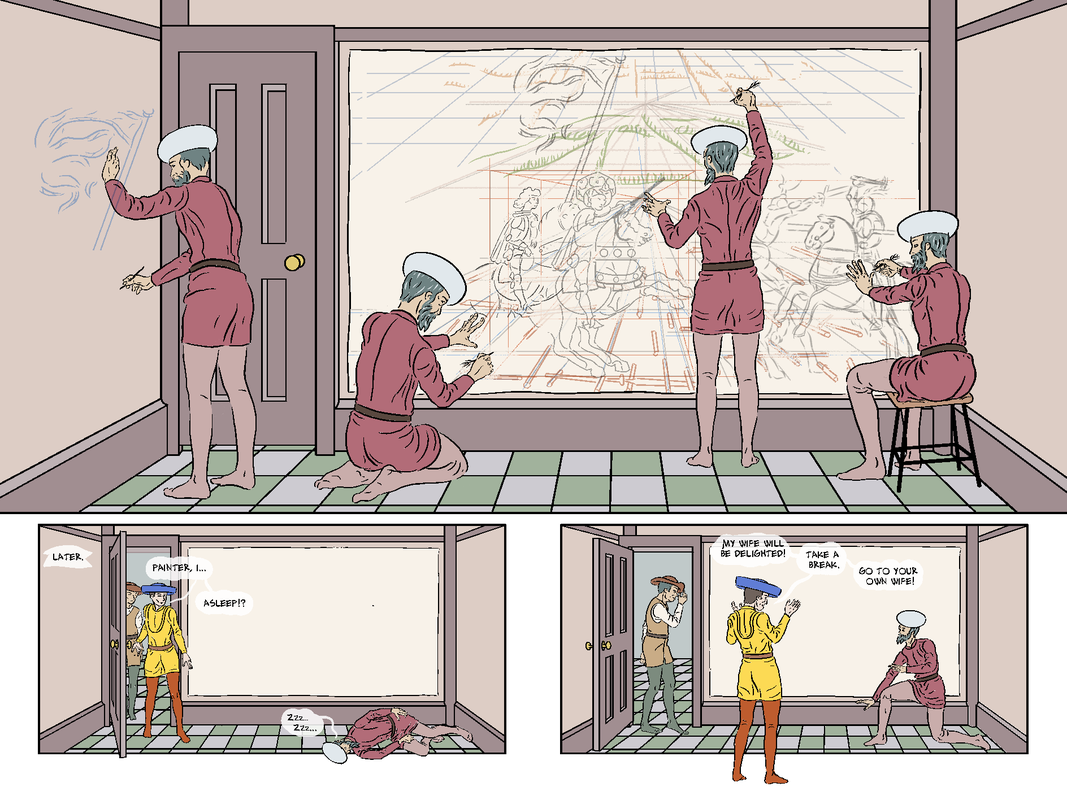
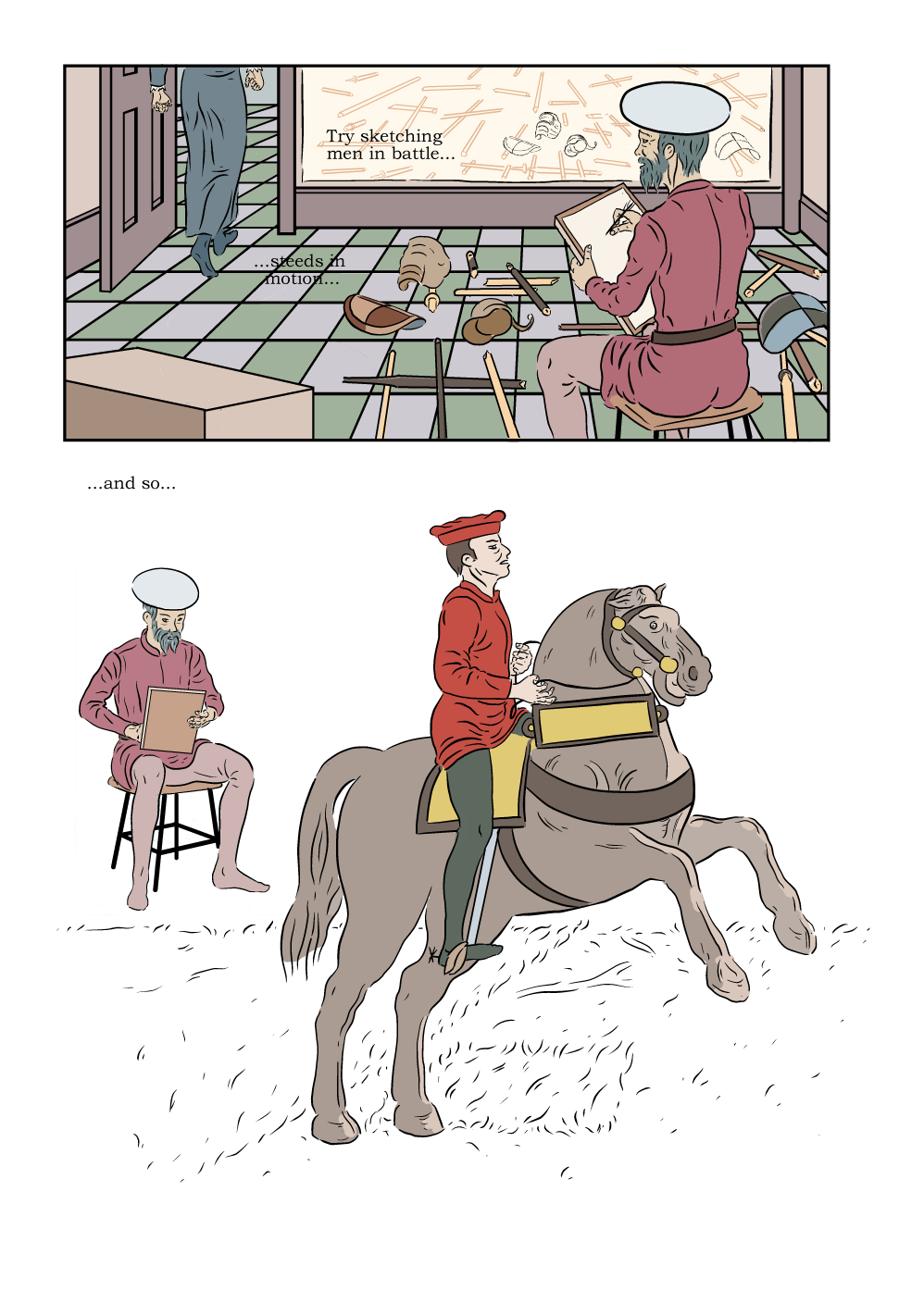
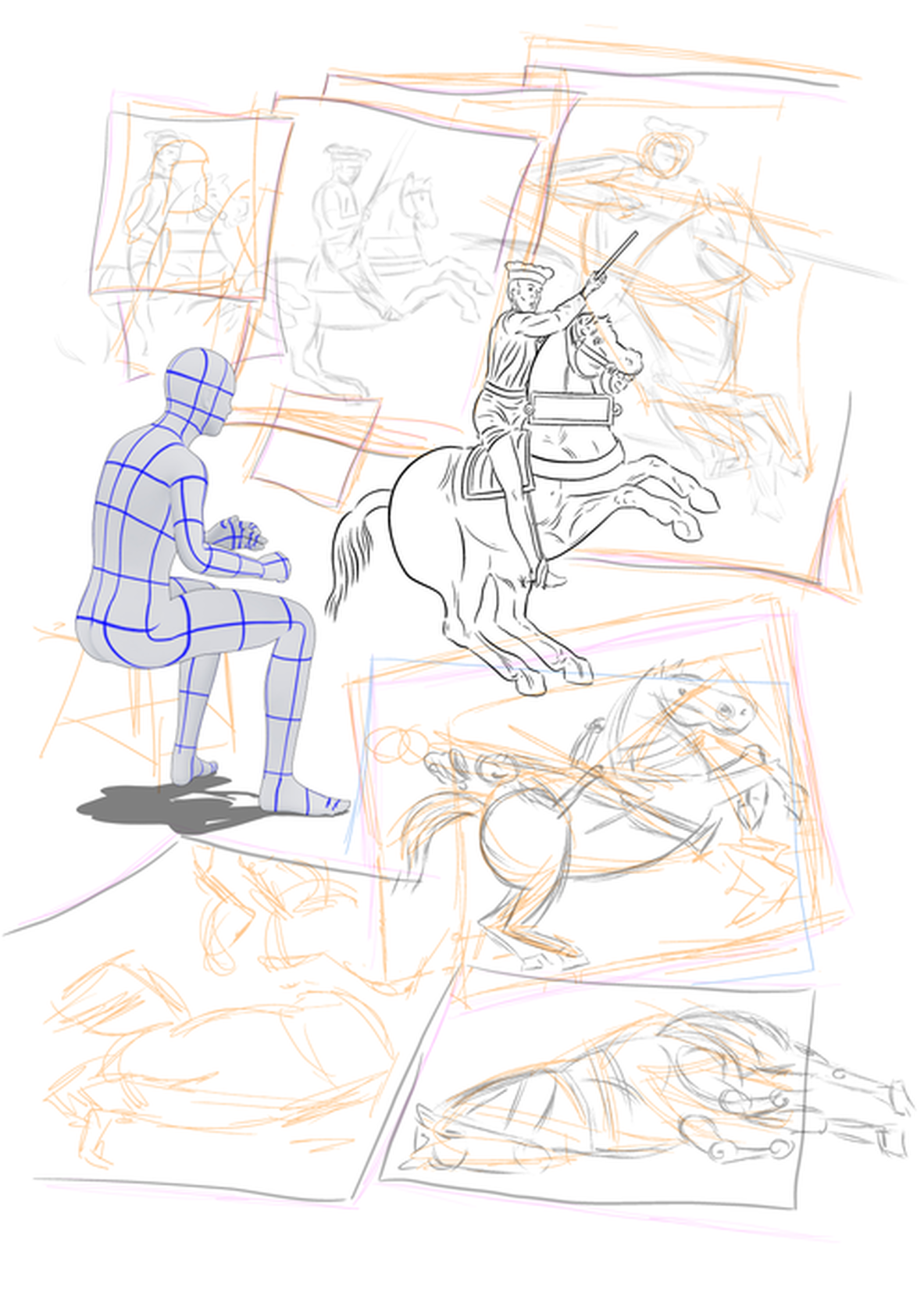
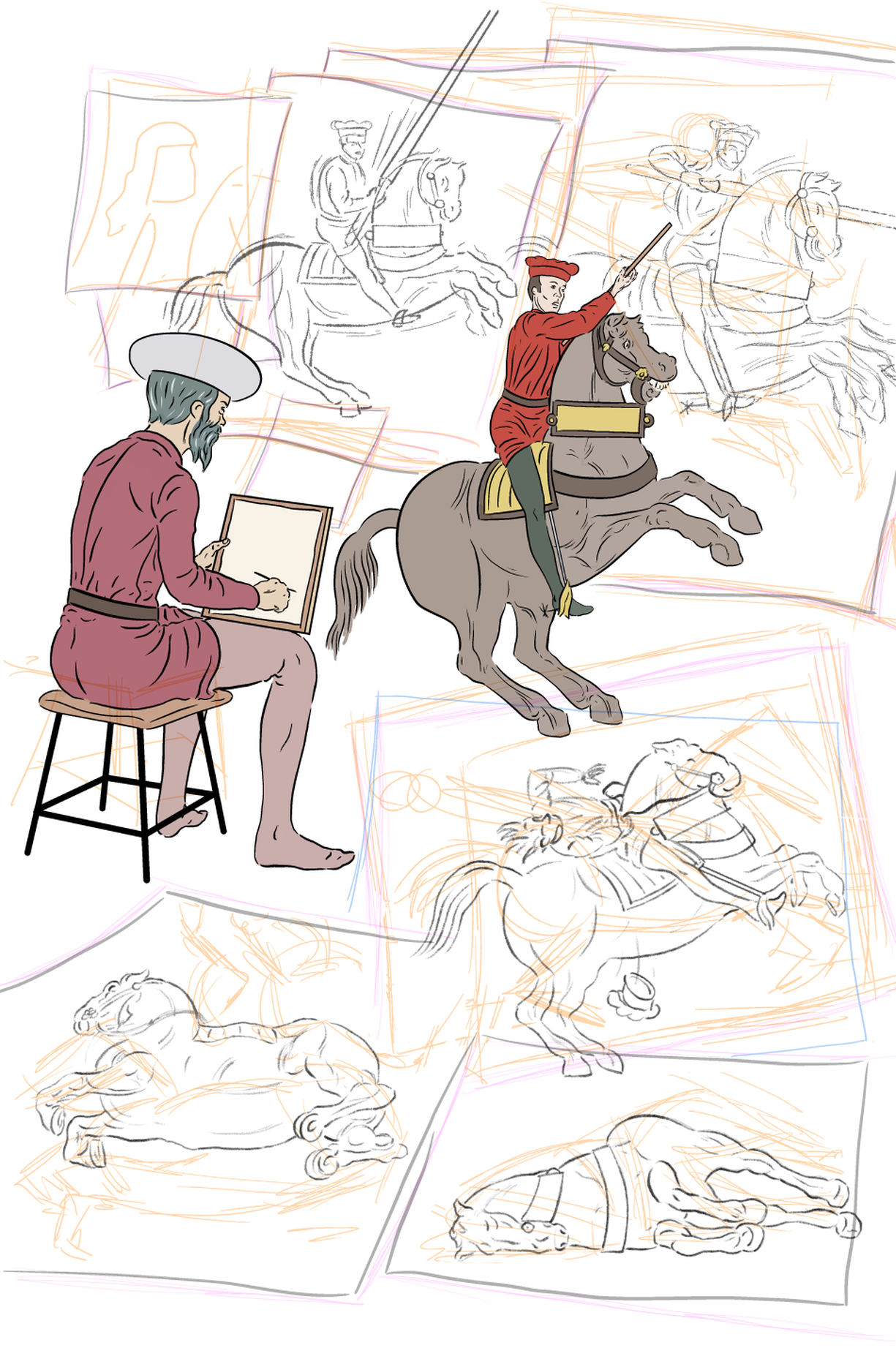
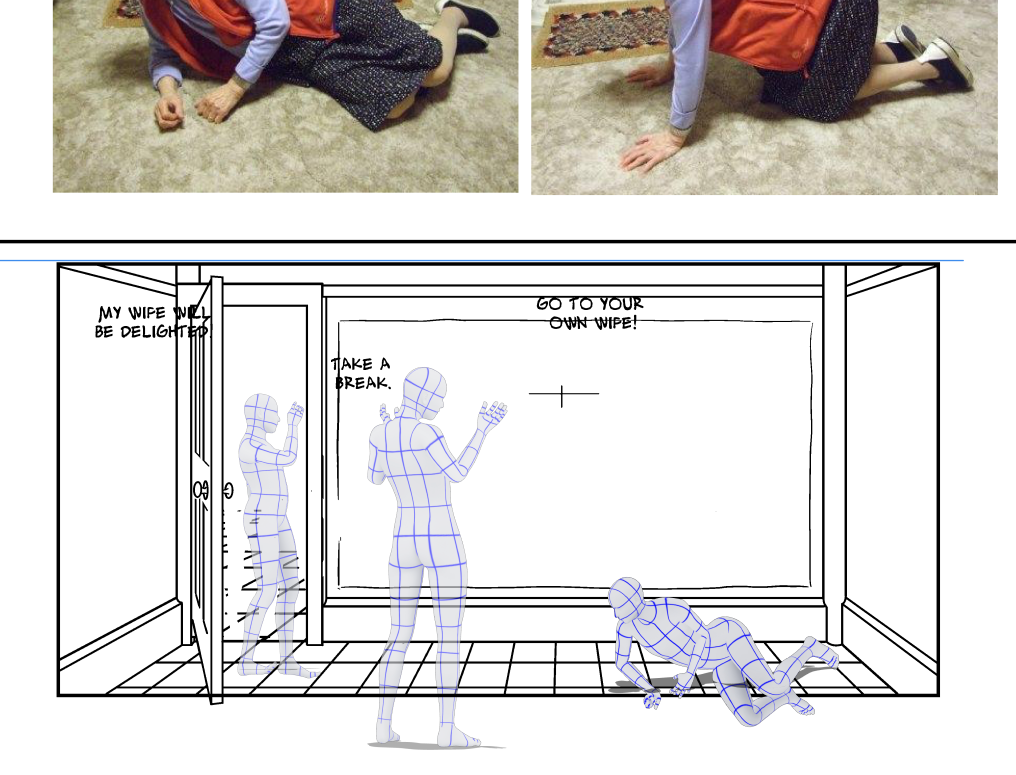
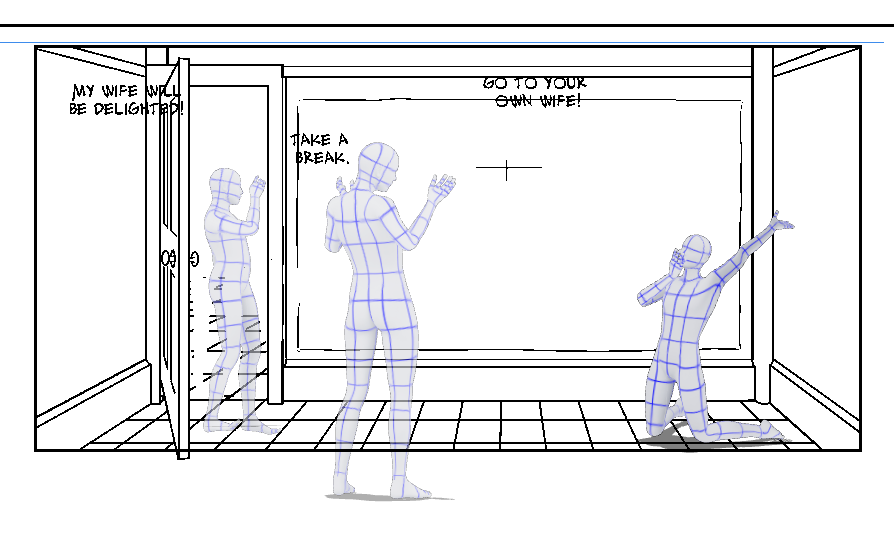
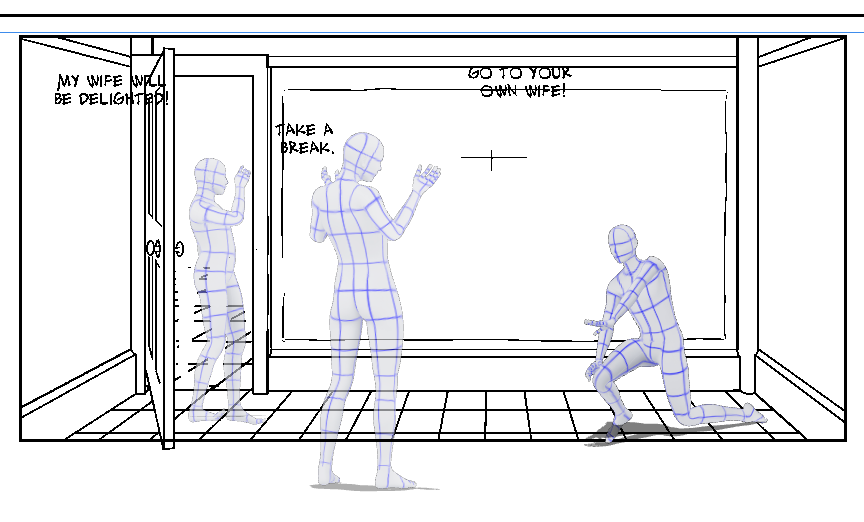
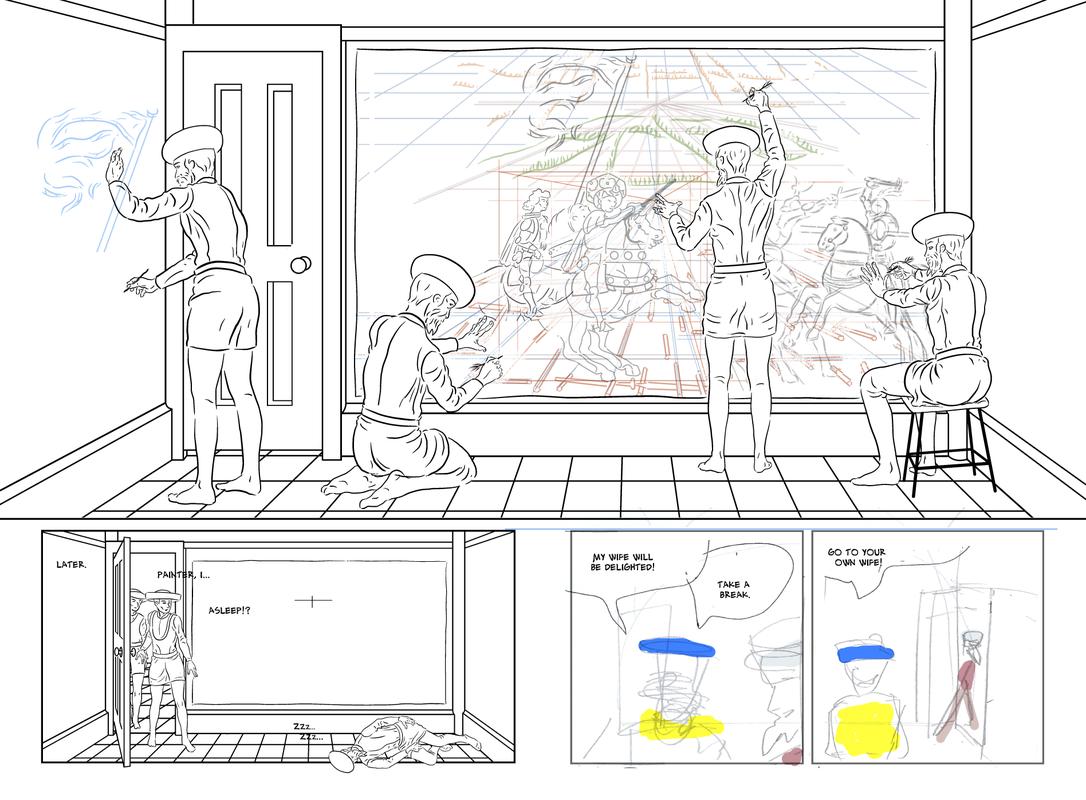
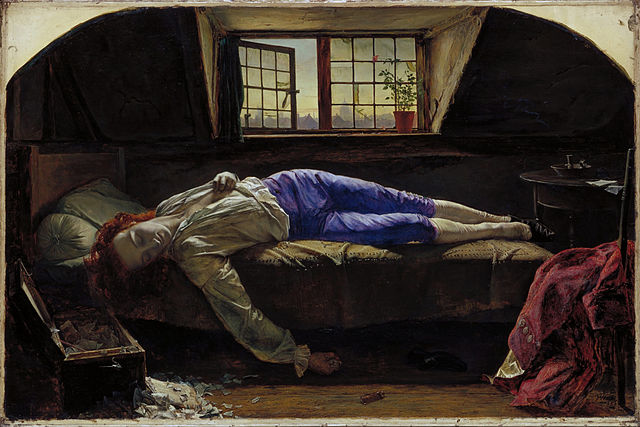
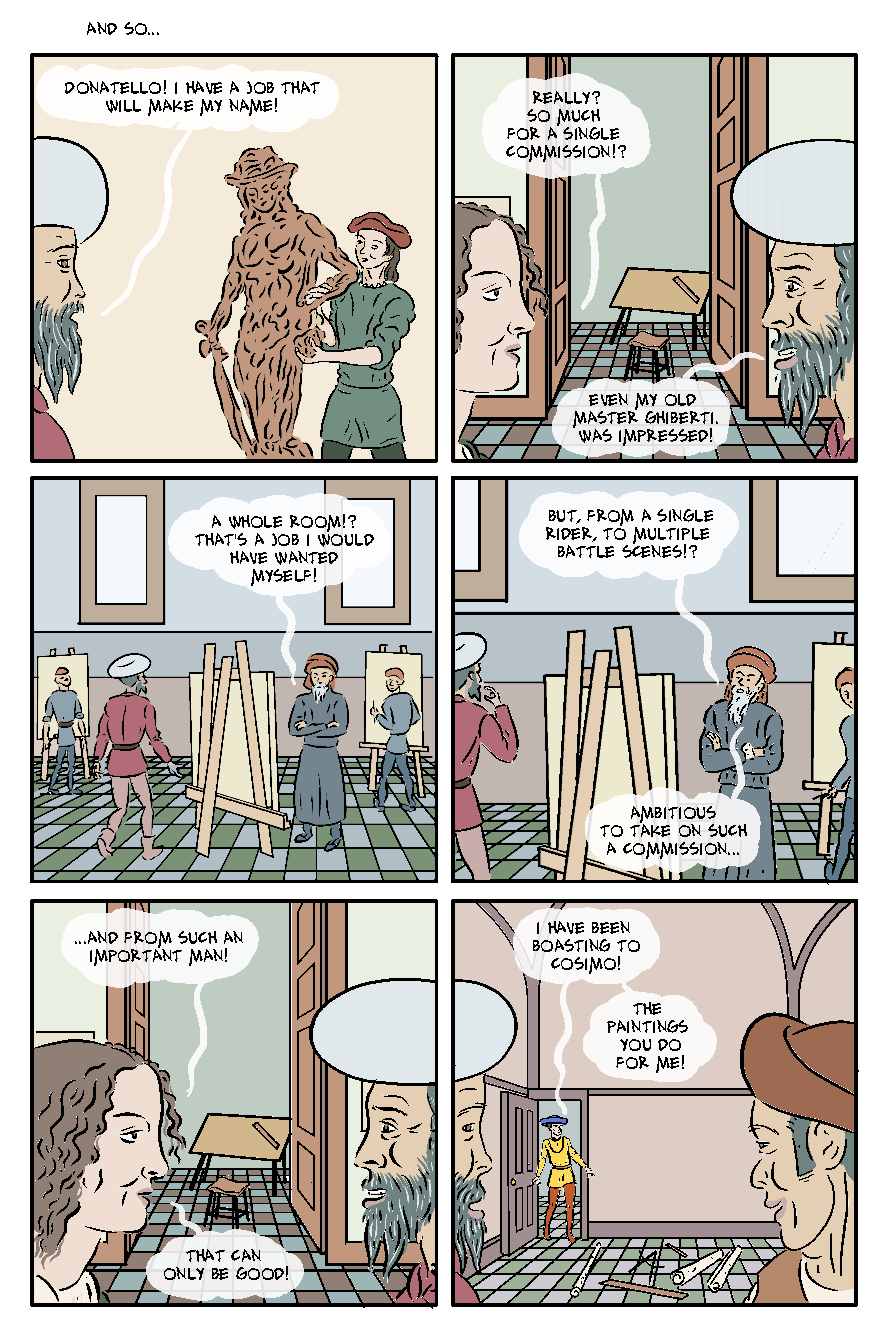
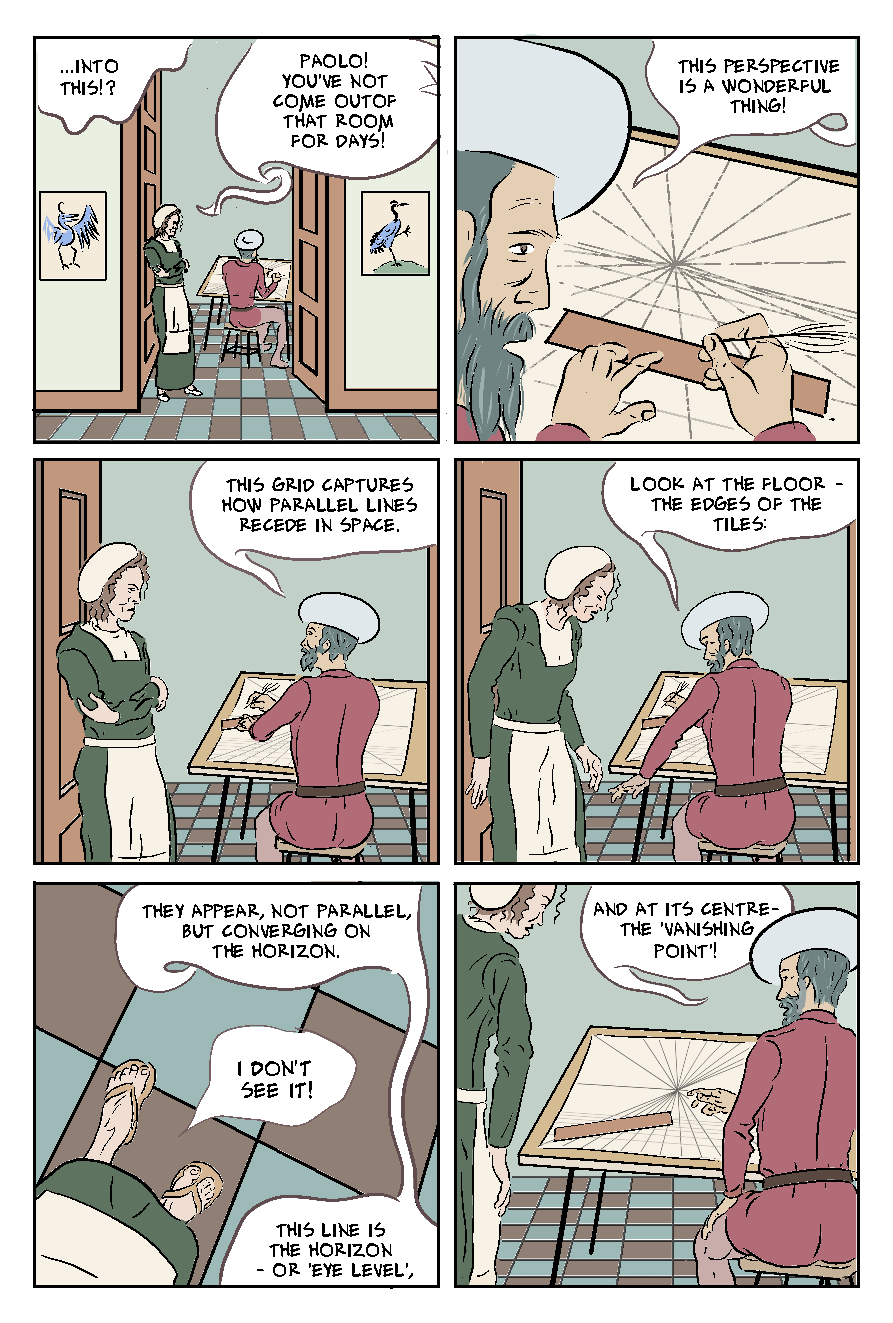
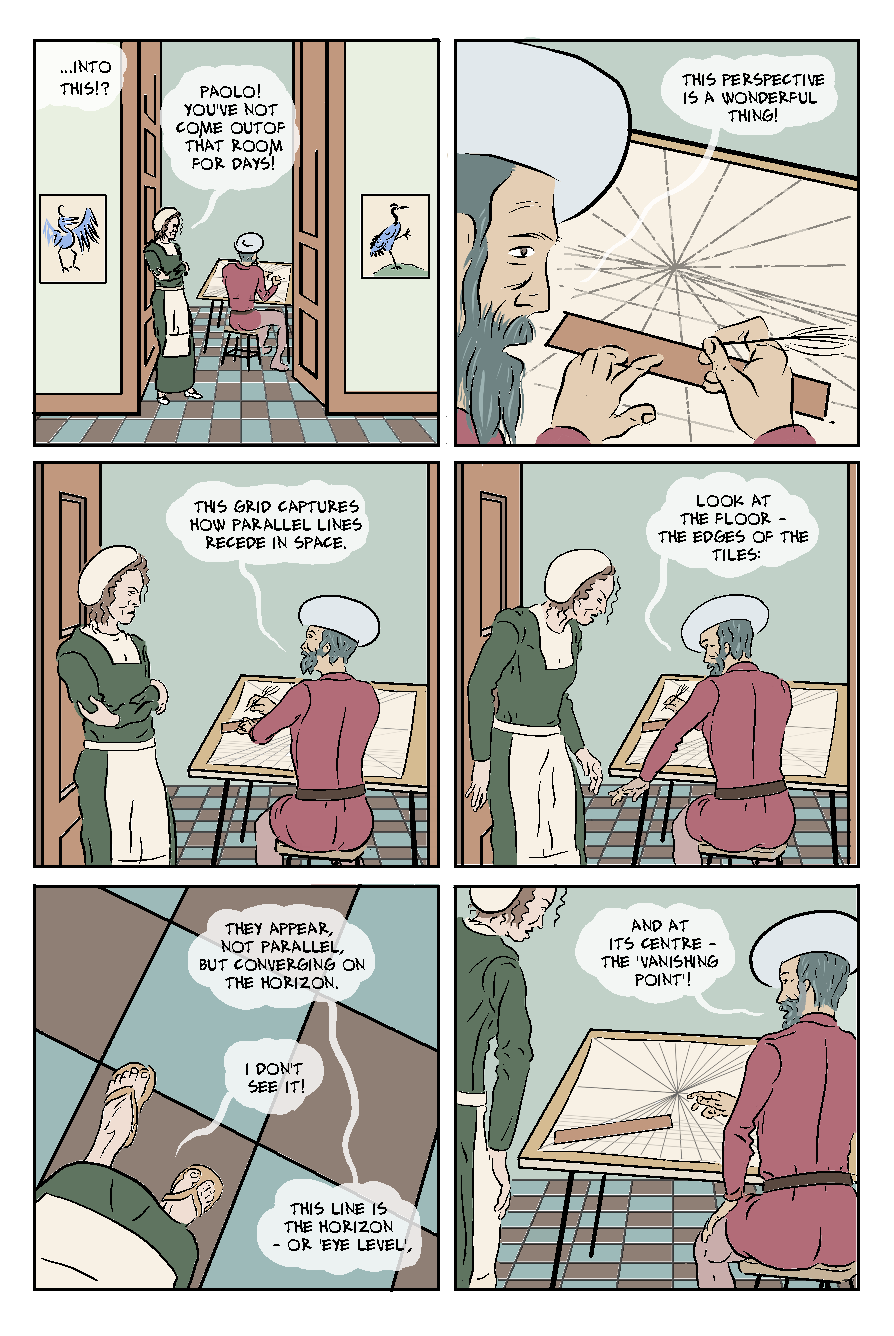
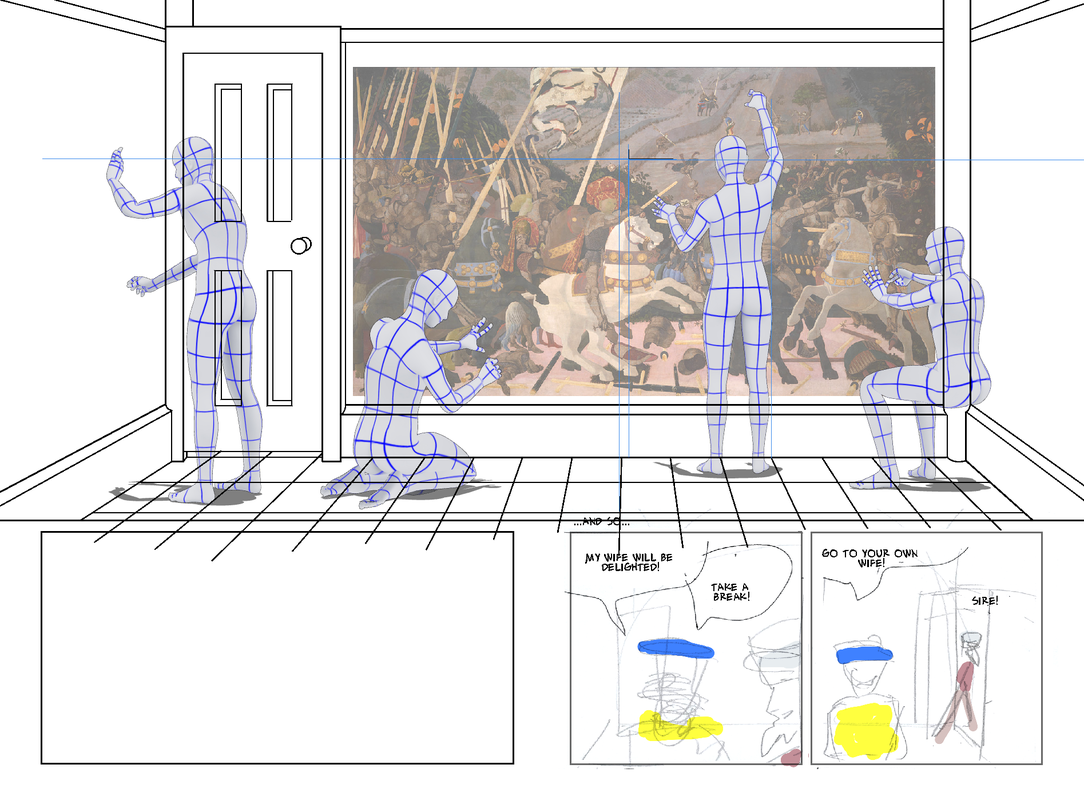
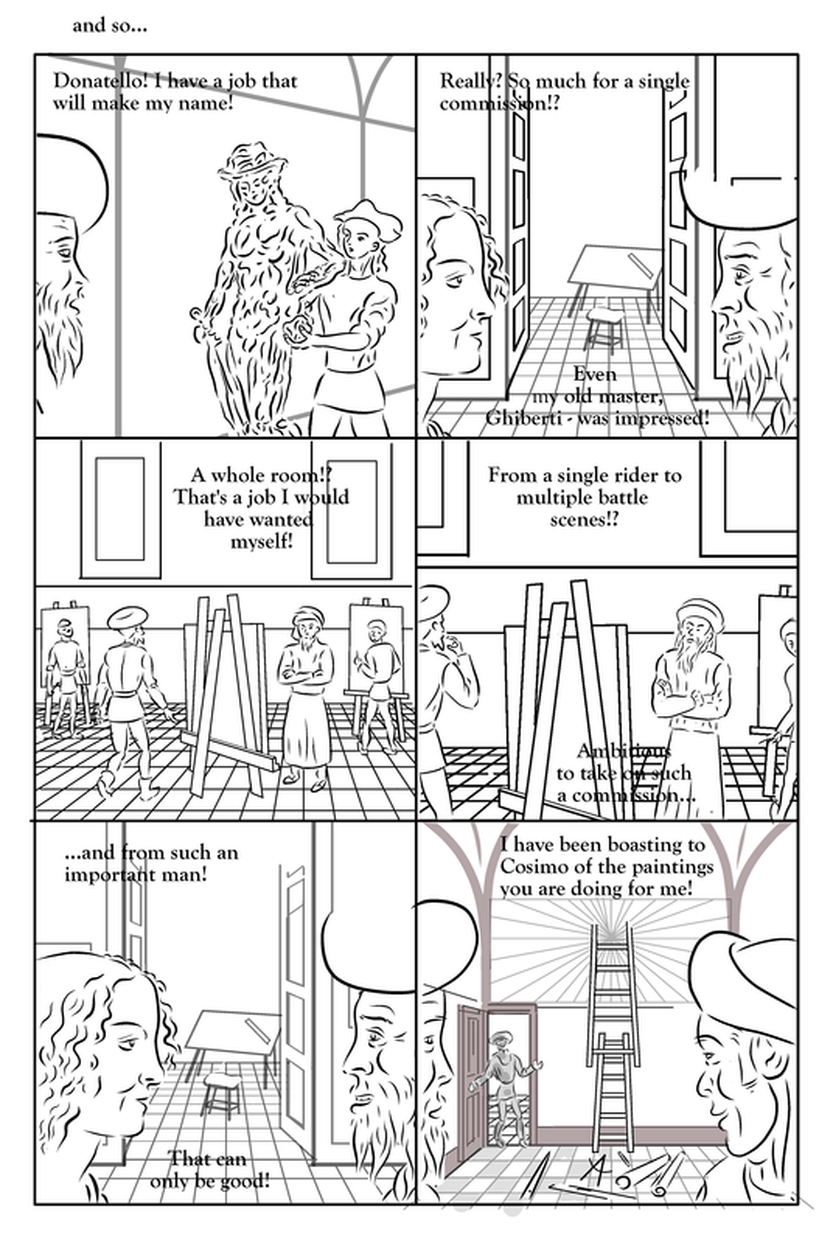
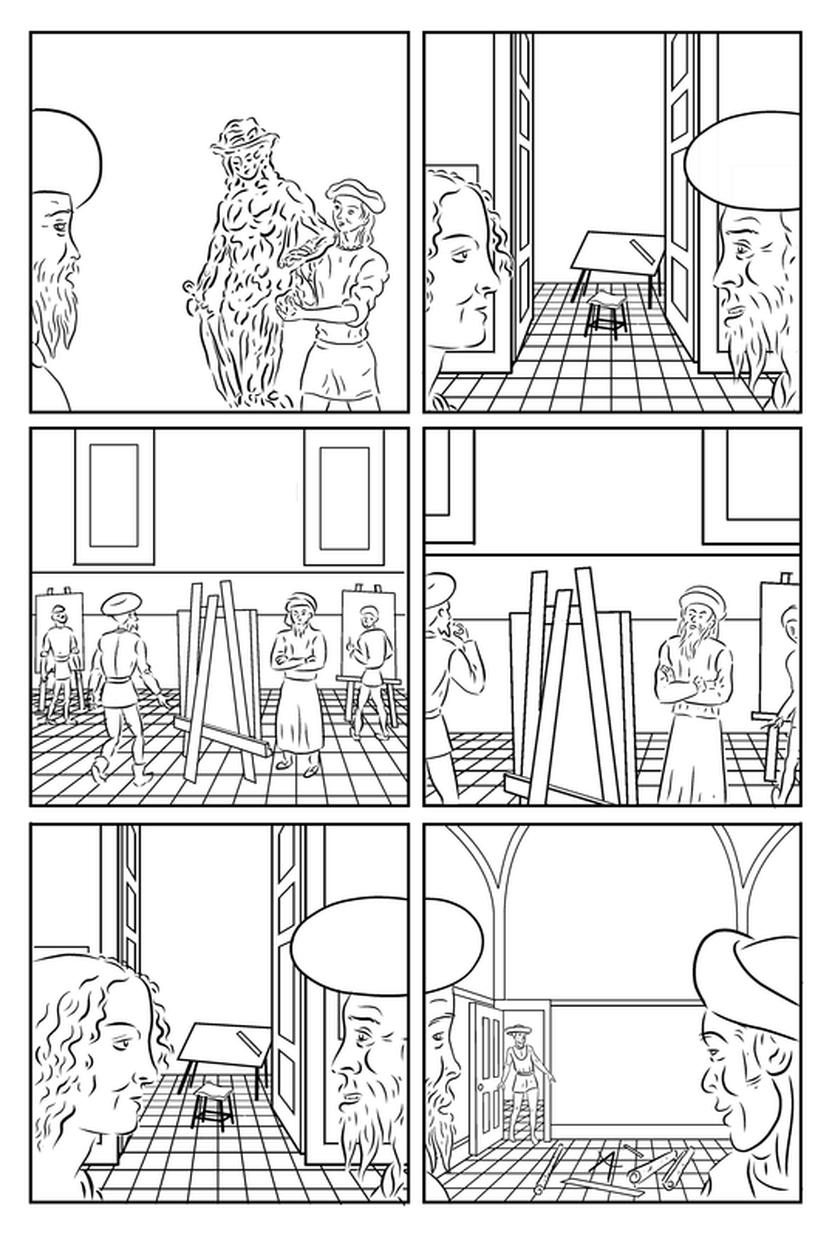
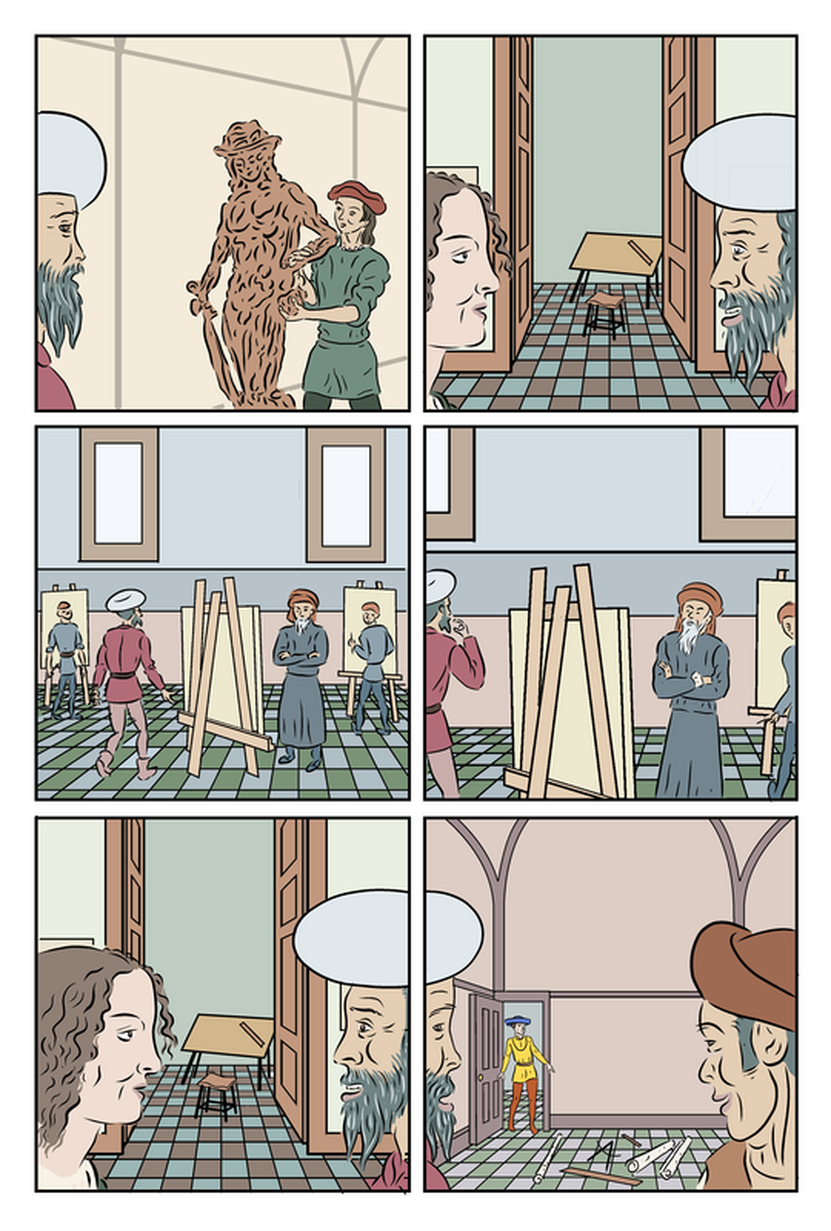
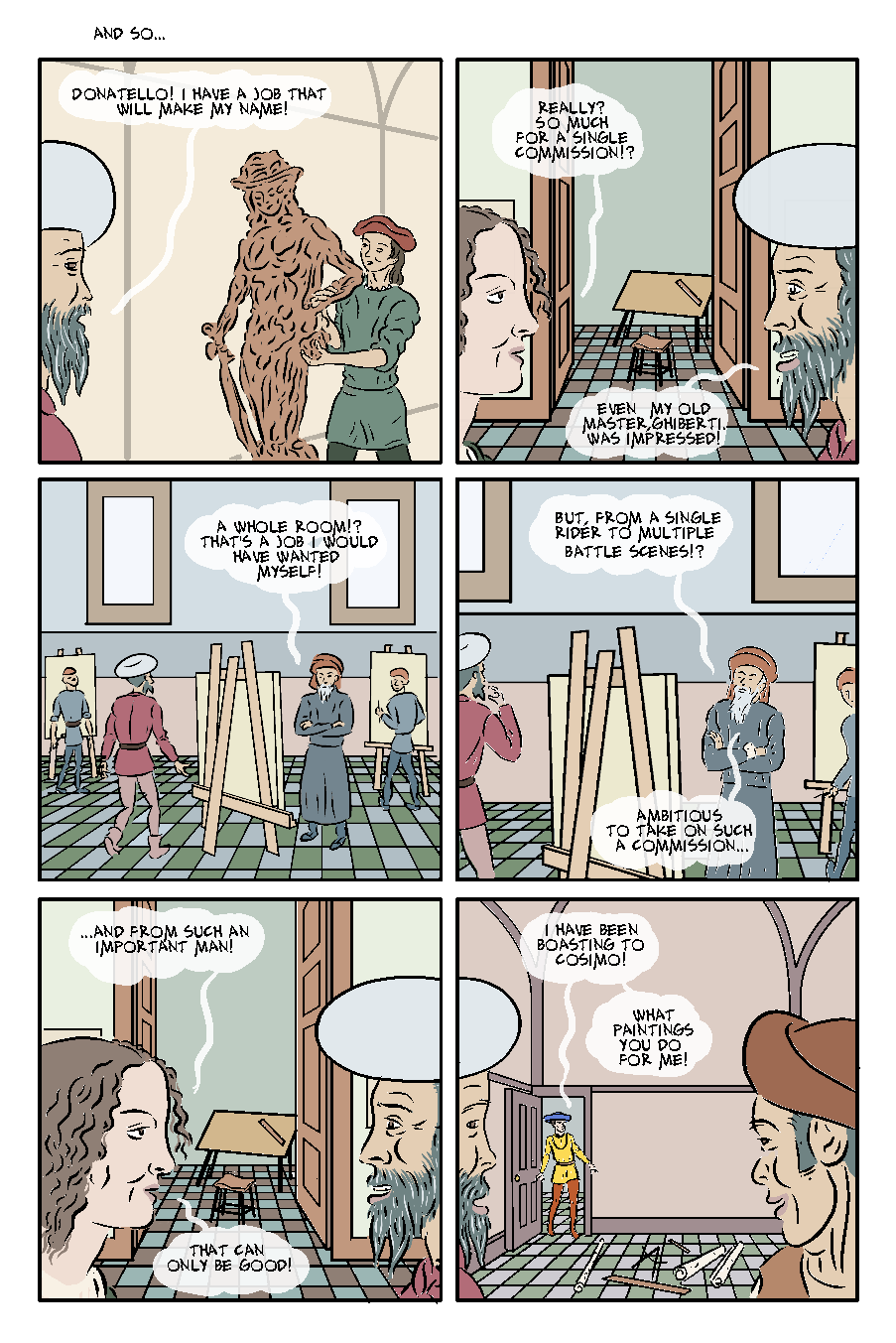
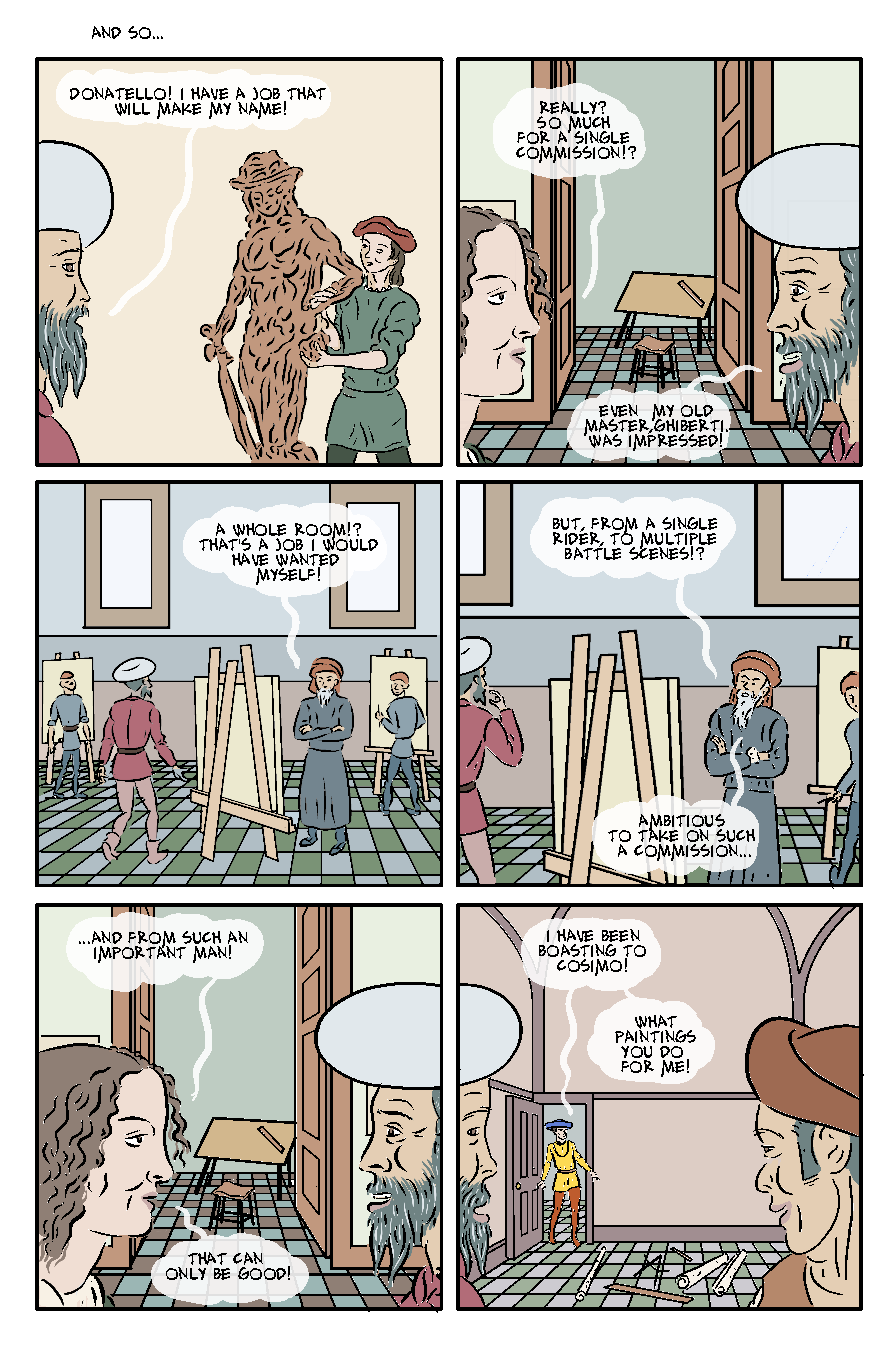
 RSS Feed
RSS Feed